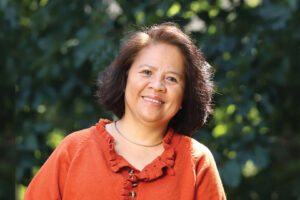Limiting radiation exposure to normal tissue around the heart and lungs is a primary goal during breast cancer treatment. CentraState is now one of a few facilities in New Jersey to offer a new technique called deep inspiration breath hold (DIBH), which takes breathing and the movement of the heart into account to further protect normal tissue during radiation treatment. Neesha Rodrigues, MD, a radiation oncologist on staff at CentraState, answers questions about this technology.
How does DIBH work?
When a patient takes a deep breath and holds it, the lungs and chest wall expand, moving the heart away from the breast and out of the treatment field. The technology ensures that the radiation beam is turned on only during this ideal respiratory point, precisely targeting the tumor and avoiding heart tissue. The treatment is delivered by a radiation therapist highly trained in this technique.
How do you determine the ideal breath hold?
We start with a CT scan to determine whether the heart will be in the treatment field, and then we guide our patients in practicing deep breaths to establish lung volume and the optimal breath hold. An additional CT scan while the patient is holding her breath helps us plan the exact course of treatment.
What is the patient’s role in DIBH?
DIBH is really controlled by our patients, and it’s meant to be as comfortable as possible. When they’re ready to hold their breath at the specified level, the treatment begins. If they need to exhale, we turn the radiation beam off. Specialized video goggles enable patients to visualize their breathing cycle and target point, so they know exactly how deep to breathe in.
Who is a candidate for DIBH?
DIBH is designed for women with left-sided breast cancer due to the proximity of the heart to the left breast. Some women have a natural space between the heart and the chest wall, so DIBH isn’t needed. DIBH benefits those whose heart and chest wall are closer together, because taking a deep breath allows for a separation between the two. Patients receiving DIBH should also be able to hold their breath for 20 to 30 seconds.
What other cardiac-sparing techniques are available?
Our physics team carefully plans and personalizes each patient’s treatment to shield heart tissue, including designing the beam angle and dose with precision. Many patients also benefit from receiving radiation while lying on their stomach, because this allows the breast to fall away from the chest wall naturally. We ensure that each patient gets the best treatment tailored to their specific anatomy and circumstances, while sparing normal tissue to the greatest extent possible—so that they can enjoy the best possible longer-term quality of life with a minimum of side effects.
For more information about CentraState’s radiation oncology services, or call 855-411-CANCER (855-411-2262).





